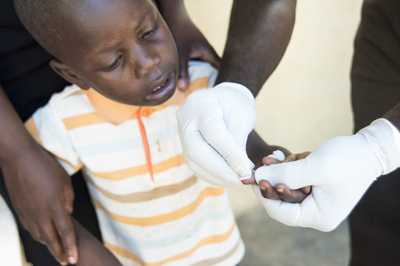AMD Project: Detecting Changing Parasites
Using AMD methods to develop tools to detect changes in parasites that cause malaria

Photo credit: David Snyder/CDC Foundation
Rapid Diagnostic Tests (RDTs) are an important tool for detecting malaria in remote communities. But the parasites that cause malaria are changing in ways that make RDTs less reliable. CDC scientists are using AMD methods to find out how the parasites are changing.
While the United States successfully eliminated malaria inside its borders decades ago, this parasitic disease is still a global threat that kills over 400,000 people each year. The best way to keep our country free of malaria is to help control it elsewhere. And one of the most critical tools for controlling this mosquito-borne disease is the Rapid Diagnostic Test (RDT), which diagnoses malaria in 15–20 minutes. RDTs do not require special training, which makes them perfect for malaria testing in remote communities with few medical workers. In fact, the World Health Organization reports that the African region has increased its testing rates by 71% thanks to the availability of RDTs. But recently, global public health partners have found that the malaria parasites are mutating in a way that makes RDTs less reliable. To find out how the parasites are changing, CDC scientists are using advanced molecular detection (AMD) to investigate these mutations and develop tests that can keep pace with changing malaria parasites.
Current RDTs work by detecting a particular protein produced by Plasmodium falciparum, the parasite that causes most malaria. But some P. falciparum parasites have stopped producing this protein, so the RDTs don’t always show that a patient has malaria. And there is some evidence that these mutated parasites are spreading through areas of Latin America and sub-Saharan Africa. But no one is certain how common these mutations are or where else the mutated parasites might be.
In this project, CDC investigators are using AMD methods to devise new and faster ways to look at P. falciparum DNA and detect when the proteins required for proper diagnosis are missing. This will help us both track and map the global prevalence of P. falciparum parasites that lack the necessary protein for successful malaria diagnosis. Understanding how the parasites are evolving the ability to delete important proteins, such as those used in RDTs, will help us develop new, more effective diagnostic tests for malaria in the future.
- Page last reviewed: March 27, 2017
- Page last updated: March 27, 2017
- Content source:


 ShareCompartir
ShareCompartir